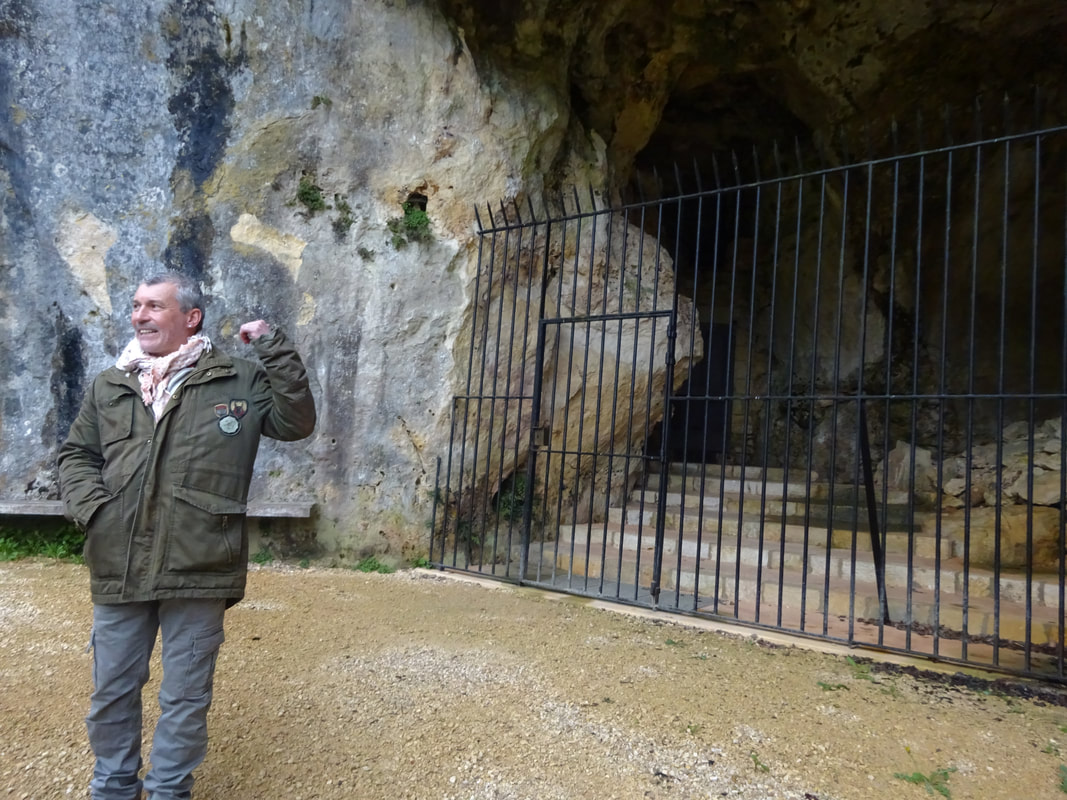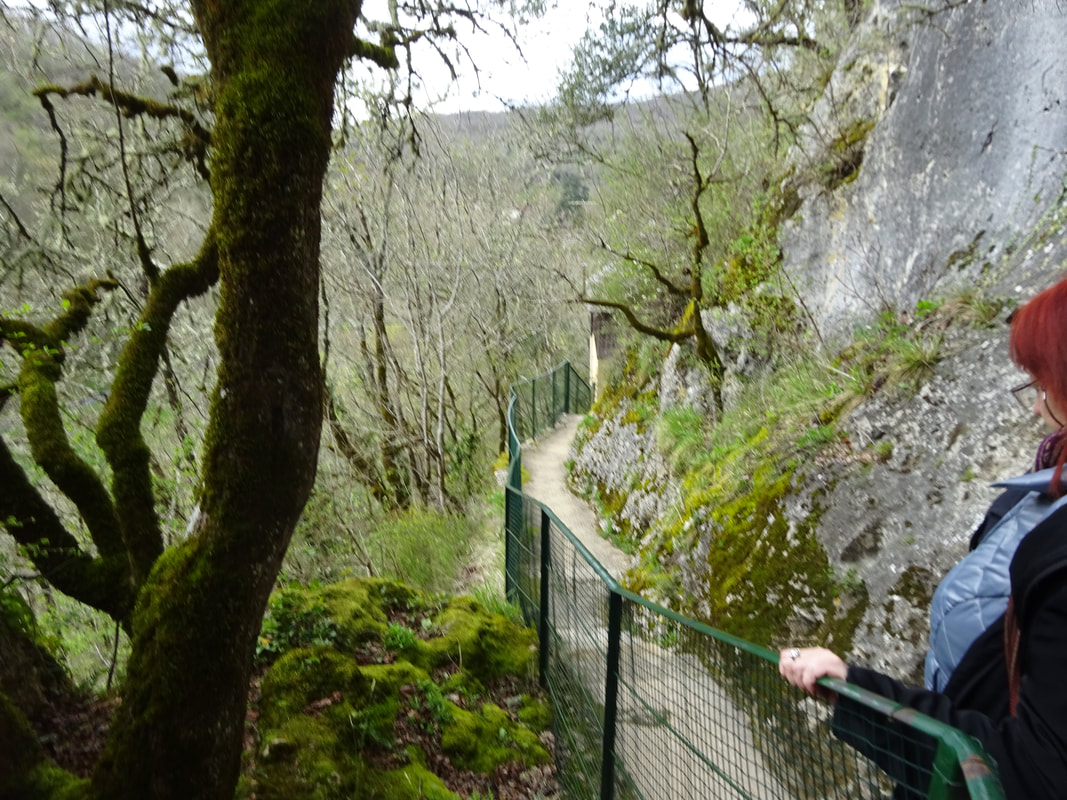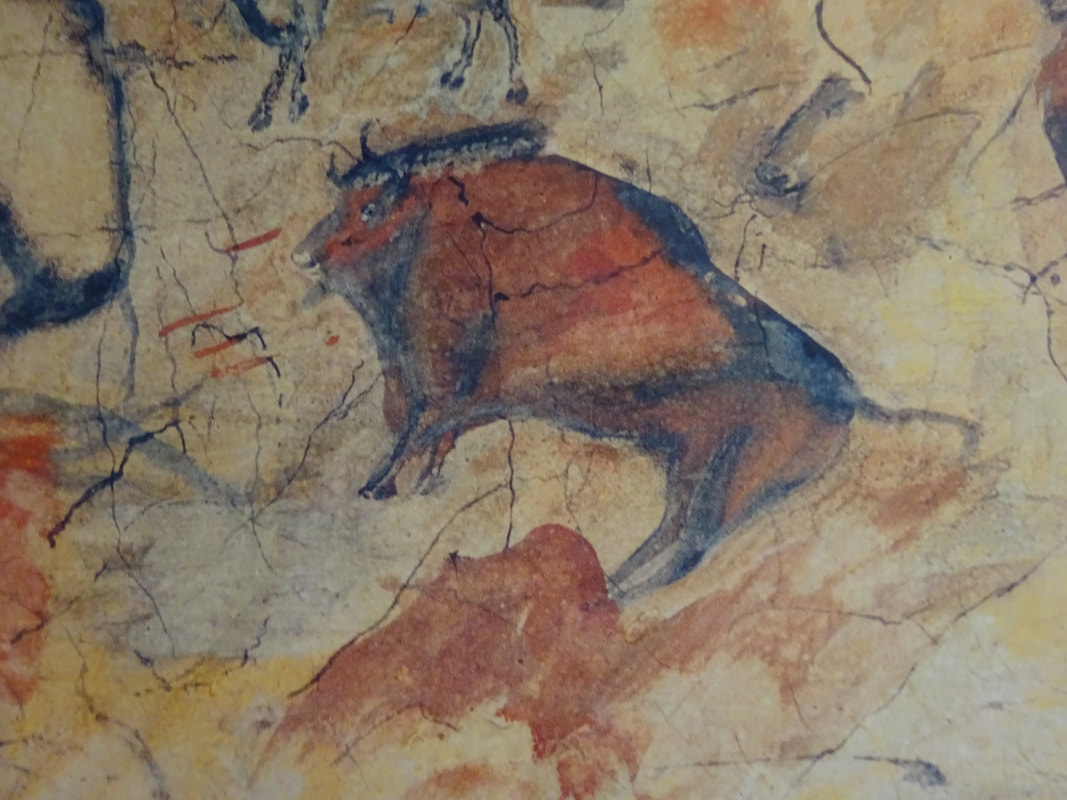9 April 2018
(painting by Charles R. Knight)
"Font-de-Gaume is a cave near Les Eyzies-de-Tayac-Sireuil. The cave contains prehistoric polychrome cave paintings and engravings dating to the Magdalenian period. Discovered in 1901, more than 200 images have been identified.
The paintings were discovered by Denis Peyrony, a local schoolmaster, on 12 September 1901. The cave had been known to the general public before this, but the significance of the paintings had not been recognized. Four days earlier Peyrony had visited the cave at Les Combarelles, a short distance away, with the archaeologist Henri Breuil, where he saw its prehistoric engravings.
Prehistoric people living in the Dordogne Valley first settled in the mouth of Font-de-Gaume around 25,000 BC. The cave mouth was inhabited at least sporadically for the next several thousand years. After the original prehistoric inhabitants left, the cave was forgotten until the nineteenth century when local people again began to visit the cave. The paintings date from around 17,000 BC. The cave's most famous painting, a frieze of five bison, was discovered accidentally in 1966 while scientists were cleaning the cave.
As of 2007, Font-de-Gaume was the only site in France with polychrome cave paintings that is still open to the public.
230 figures have been recorded in the cave, and it is thought that more are still to be revealed. These engravings are considered the best examples of polychrome painting other than Lascaux, which is now closed to the public. The rock art in Font-de-Gaume includes depictions of more than 80 bison, approximately 40 horses, and more than 20 mammoths.
Les Combarelles is a cave in Les Eyzies de Tayac, Dordogne, France, which was inhabited between 13,000 to 11,000 years ago. Holding more than 600 prehistoric engravings of animals and symbols, the two galleries in the cave, as well as Font de Gaume, were crucial in the re-evaluation of the mental and technical capabilities of these prehistoric humans around the turn of the last century.
Formed by an underground river, the cave is 300 m (980 ft) long with an average width of 1 m (3.3 ft). Radiocarbon dating of bones found in the cave indicate the cave was inhabited by people 13,680–11,380 years before the present. During that period, these people produced hundreds of drawings on the sandy cave walls, traces of dye suggesting the engraved drawings were originally coloured.
Scientists have identified 600–800 drawings of isolated animals and undecipherable tectiforms (i.e. upward-pointing wedges) in the cave. Horses appear most frequently in these drawings — isolated, in herds, and together with other animals — but the reindeer are famous for their naturalistic appearances — some of them drawn as if drinking water from the river flowing through the cave. Other animals include cave bears, cave lions, and mammoths.
The Abri du Poisson ("Fish Rock Shelter") is a prehistoric sculpture of a salmon, dating to the era of Paleolithic art (c.23,000 BCE). Fish are rarely depicted - only ten examples are known in the entire history of cave art during the Ice Age - and this particular relief sculpture is one of the oldest representations of a fish ever found. The salmon sculpture was carbon-dated after analysis of the red and black pigments that were found on it. In 1979, the Abri du Poisson was designated a World Heritage Site by UNESCO, along with the other sites and caves in the Vezere valley.
Abri Poisson, the shelter, was discovered in 1892 by Paul Girod. The fish sculpture, however, was first noticed on the ceiling, covered in lichens, by Jean Marsan in 1912. The following year, the Abri du Poisson was made an Historic Monument, and was later excavated by the renowned French prehistorian Denis Peyrony (1869-1954), who himself succeeded in foiling an attempt (financed by Professor Carl Schuchhardt of the Berlin Anthropological Museum) to dismantle the stone carving of the salmon."
--------
Access to view the art is strictly regulated - too many people breathing nearby would eventually destroy them. Tickets can only be purchased in-person. The guidebook said to arrive early, preferably before the ticket office opens, and occupy the numbered seat benches. 78 tickets for Font de Gaume and 42 tickets for Les Combarelles are available minus those set aside for tour groups, 26 and 7. We arrived, with breakfast snacks around 7am, and waited it out. We were there alone for about 20 minutes, and then people slowly filled out all the other positions before the ticket shop opened at 930am. We bought tickets for Font de Gaume, Les Combarelles, and the Abri du Poisson.
"Font-de-Gaume is a cave near Les Eyzies-de-Tayac-Sireuil. The cave contains prehistoric polychrome cave paintings and engravings dating to the Magdalenian period. Discovered in 1901, more than 200 images have been identified.
The paintings were discovered by Denis Peyrony, a local schoolmaster, on 12 September 1901. The cave had been known to the general public before this, but the significance of the paintings had not been recognized. Four days earlier Peyrony had visited the cave at Les Combarelles, a short distance away, with the archaeologist Henri Breuil, where he saw its prehistoric engravings.
Prehistoric people living in the Dordogne Valley first settled in the mouth of Font-de-Gaume around 25,000 BC. The cave mouth was inhabited at least sporadically for the next several thousand years. After the original prehistoric inhabitants left, the cave was forgotten until the nineteenth century when local people again began to visit the cave. The paintings date from around 17,000 BC. The cave's most famous painting, a frieze of five bison, was discovered accidentally in 1966 while scientists were cleaning the cave.
As of 2007, Font-de-Gaume was the only site in France with polychrome cave paintings that is still open to the public.
230 figures have been recorded in the cave, and it is thought that more are still to be revealed. These engravings are considered the best examples of polychrome painting other than Lascaux, which is now closed to the public. The rock art in Font-de-Gaume includes depictions of more than 80 bison, approximately 40 horses, and more than 20 mammoths.
Les Combarelles is a cave in Les Eyzies de Tayac, Dordogne, France, which was inhabited between 13,000 to 11,000 years ago. Holding more than 600 prehistoric engravings of animals and symbols, the two galleries in the cave, as well as Font de Gaume, were crucial in the re-evaluation of the mental and technical capabilities of these prehistoric humans around the turn of the last century.
Formed by an underground river, the cave is 300 m (980 ft) long with an average width of 1 m (3.3 ft). Radiocarbon dating of bones found in the cave indicate the cave was inhabited by people 13,680–11,380 years before the present. During that period, these people produced hundreds of drawings on the sandy cave walls, traces of dye suggesting the engraved drawings were originally coloured.
Scientists have identified 600–800 drawings of isolated animals and undecipherable tectiforms (i.e. upward-pointing wedges) in the cave. Horses appear most frequently in these drawings — isolated, in herds, and together with other animals — but the reindeer are famous for their naturalistic appearances — some of them drawn as if drinking water from the river flowing through the cave. Other animals include cave bears, cave lions, and mammoths.
The Abri du Poisson ("Fish Rock Shelter") is a prehistoric sculpture of a salmon, dating to the era of Paleolithic art (c.23,000 BCE). Fish are rarely depicted - only ten examples are known in the entire history of cave art during the Ice Age - and this particular relief sculpture is one of the oldest representations of a fish ever found. The salmon sculpture was carbon-dated after analysis of the red and black pigments that were found on it. In 1979, the Abri du Poisson was designated a World Heritage Site by UNESCO, along with the other sites and caves in the Vezere valley.
Abri Poisson, the shelter, was discovered in 1892 by Paul Girod. The fish sculpture, however, was first noticed on the ceiling, covered in lichens, by Jean Marsan in 1912. The following year, the Abri du Poisson was made an Historic Monument, and was later excavated by the renowned French prehistorian Denis Peyrony (1869-1954), who himself succeeded in foiling an attempt (financed by Professor Carl Schuchhardt of the Berlin Anthropological Museum) to dismantle the stone carving of the salmon."
--------
Access to view the art is strictly regulated - too many people breathing nearby would eventually destroy them. Tickets can only be purchased in-person. The guidebook said to arrive early, preferably before the ticket office opens, and occupy the numbered seat benches. 78 tickets for Font de Gaume and 42 tickets for Les Combarelles are available minus those set aside for tour groups, 26 and 7. We arrived, with breakfast snacks around 7am, and waited it out. We were there alone for about 20 minutes, and then people slowly filled out all the other positions before the ticket shop opened at 930am. We bought tickets for Font de Gaume, Les Combarelles, and the Abri du Poisson.
First up, Les Combarelles - we met up with our guide and about 8 others in the tan building. The promised English speaking guide didn't happen, however, one of the French tourists translated the guide's descriptions for us. The engravings, not paintings here, were not easily discernible at first especially in the low light.
Abri du Poisson ("Fish Rock Shelter") was up next. We found parking where it appeared they wanted us to park, and hiked a bit along the road to what seemed like the entrance. No one was there at the appointed time, and so we decided to hike in along a trail thinking they'd commenced without us. Then we turned around and then found the guide and a couple others parking near the trail entrance. The entrance is at least a 1/4 mile up along a stream. The holes/slots are from the attempted removal.
Finally, Font-de-Gaume, with a hike up, up, up, from the ticket office.
These photos are from the museum we visited afterwards that presented both recreated cave art and photos.



















 RSS Feed
RSS Feed
